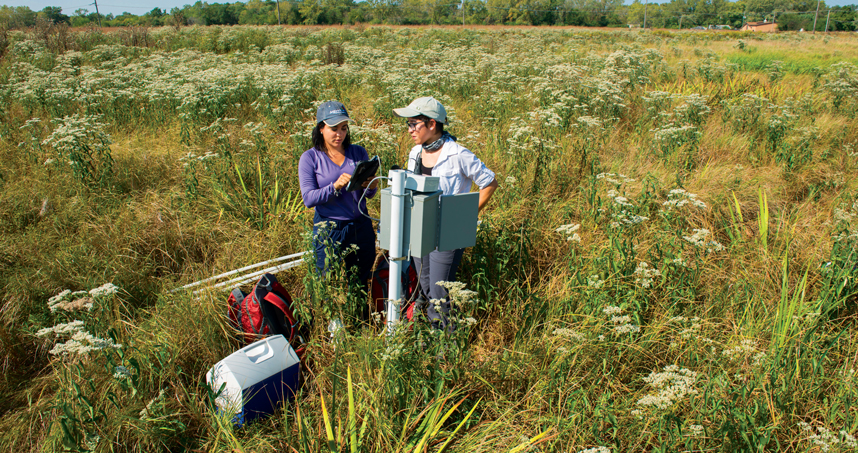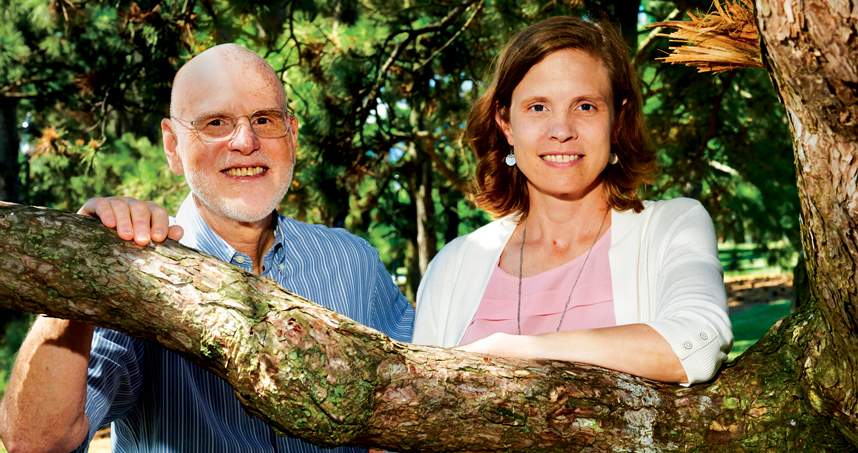Engineering a Sustainable Future
New Center for Engineering Sustainability and Resilience sparks interdisciplinary collaboration to solve some of the world’s most pressing environmental issues.
From technology that harvests water from air to a blueprint for a modern and resilient “living city,” researchers at Northwestern Engineering are taking the lead on our planet’s most challenging environmental issues.
These researchers now have a strong ally in their fight: Northwestern’s Center for Engineering Sustainability and Resilience (CESR). This new interdisciplinary center brings together engineers and researchers from across the University and beyond to jumpstart research and innovative technologies that tackle complex sustainability challenges like climate change, water quality, clean energy, and pollution.
“There’s already a lot going on in sustainability research and education at Northwestern,” says Bill Miller, professor of chemical and biological engineering and director of the center. “We can help coordinate and promote that work within our school and connect it to our partners.”
Already, the University has more than a dozen organizations studying sustainability-related issues, from the Institute for Sustainability and Energy at Northwestern to the Northwestern Center for Water Research to the Northwestern University Transportation Center. CESR will play a unique role.
“We’re going to be facilitators and enablers,” says Miller. “We don’t want to subsume the great centers that already exist. We want to illuminate how they connect while looking to contribute in ways that will benefit everyone.”
Boasting more than 50 affiliated faculty members from nearly every academic discipline at the McCormick School of Engineering, the new center propels collaboration by connecting faculty and students with related research interests in areas like climate change mitigation, water systems and reuse, and sustainable manufacturing.
Earlier this year, Miller worked with students in a Segal Design Institute course to adapt an urban environmental monitoring system developed by Argonne National Laboratory for use at Gensburg-Markham Prairie, located 25 miles south of downtown Chicago. The collaboration produced designs for an off-the-grid, environmentally friendly system to power monitoring nodes in the prairie nature preserve that measure air quality, environmental parameters, and light intensity.

“Students are interested in exploring sustainability as part of their undergraduate or graduate work,” says Jennifer Dunn, associate director of CESR, research associate professor at Northwestern Engineering, and director of research at Northwestern Argonne Institute of Science and Engineering. “There’s a hunger there that we want to feed with new opportunities to learn and explore.
CESR will also host interactive workshops and symposia, welcoming sustainability leaders from academia, government, nonprofits, and industry to foster dialogue and spark new collaborations with Northwestern Engineering. As Miller points out, “We don’t want to just study sustainability, we want to actively promote it.”
Workshopping a Sustainable Chicago
In July, CESR held its inaugural event spotlighting a core research area: sustainable urban systems. Leaders from Northwestern, Argonne, the Field Museum, the Nature Conservancy, and others convened to discuss and adopt short-term initiatives that could improve the sustainability and quality of life in communities around Chicago, as well as identify multidisciplinary long-term research needs for developing more sustainable urban systems.
"Connecting and leveraging everyone's knowledge is important, and the center will encourage that even more strongly going forward."
The two-day event embodied Miller and Dunn’s vision: engineers, scientists, journalists, lawyers, architects, social scientists, and industry professionals working together with representatives from community organizations and regional governments, bridging expertise, and approaching major environmental and societal challenges holistically.
“If you think about how to mitigate urban flooding, for example, you need people who understand water quality impacts, hydrology impacts, and green infrastructure,” Miller says. “It was important that we left the discussion with actionable takeaways that work for the people who will be responsible for implementing them.”
“You want to avoid fixing one problem while creating another,” Dunn adds. “Connecting and leveraging everyone’s knowledge is important, and the center will encourage that even more strongly going forward.”
Bringing Concept to Life Through Collaboration

Looking ahead, Miller and Dunn hope CESR will help spur blue-sky research and education initiatives by supporting faculty and students seeking funding opportunities or by cultivating industry and nonprofit partnerships. Dunn already sees tangible evidence of the new center’s impact on collaboration.
“It’s exciting to see the new ideas that arise when you bring people together,” Dunn says. “There’s an enthusiasm from the connections people have made and the ideas that have bubbled up. We’re excited to help make those ideas a reality.”
